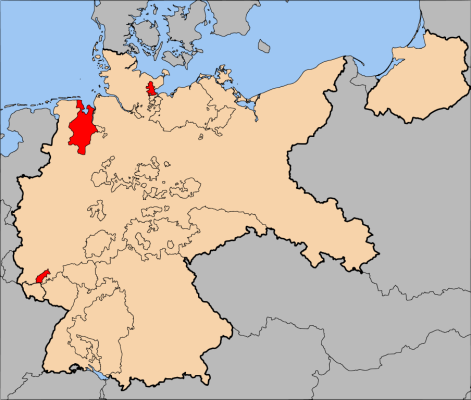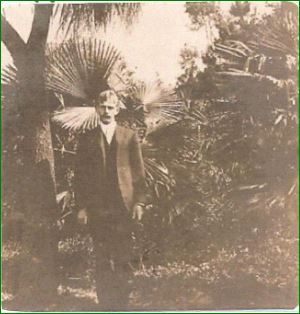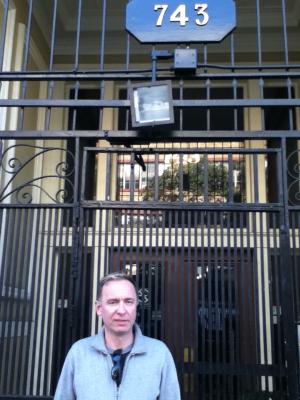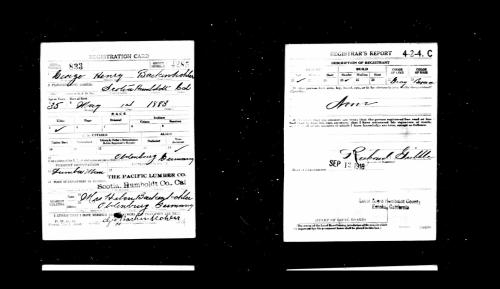George was born on May 14, 1883 in the town of Elsfleth in an area called 'Wesermarsch' in the former state of Oldenburg, just a few kilometers northwest of Bremen. His family moved around the state of Oldenburg and ended up in the the town of Neuenburg in the southern part of is now know as the county of Friesland. This is the place where he spent most of his childhood and youth. His parents were Helene Brüggemann and Johann Gerhard Hinrich Backenköhler. His father began his career as a soldier in the army of the state Oldenburg and was decorated with several medals for his service during the Austrian-Prussian War of 1866.
The following map might give you an idea of the area where George and his family lived in the late 19th century:

Later, he became a police officer with the rank of a sergeant in the Oldenburg State Police and was finally transferred to Neuenburg. Stories concerning his person did the round in that little town for a long time after his death in 1899 and were reportedly used in the 1910's to instill fear and respect in children.
George had seven siblings: three brothers and four sisters.
Willi, father to Elfriede, moved to Dresden and became an engineer.
August Friedrich, a butcher who was living in Bremen.
Friedrich August, captain of a German merchant vessel and father to three girls: Olga, Marge and Irmgard.
George's sister Anna, who lived in San Rafael for a few years, before moving back to Germany months before the 1906 San Francisco earthquake.
Magdalene met her husband Frank A. Suter in the aftermath of the same earthquake and spend the rest of her life in the city of San Francisco.
In addition to that, there were two more sisters, Helene and Henriette, plus two other siblings who died soon after birth.
After his sisters Magdalene and Anna had already immigrated to the United States, George, too, arrived on Ellis Island with the steamship “Friedrich der Grosse” (that is German for “Frederick the Great of Prussia”) on April 20, 1899.
On his “Certificate of Immigration” an officer noted that George’s profession was “clerk”. His alleged destination was San Francisco, where he wanted to visit his sister Magdalene. The US census of 1900 listed George as living in Bennett Valley near Santa Rosa at the farm of his uncle Frederick Brueggemann.

A man, supposedly George Henry Backenköhler, standing in the garden of Brüggemann’s Farm in Bennett Valley.
The Brüggemann family, who were relatives of his mother’s, owned a farm in Bennet Valley. George was staying at their place, working as a day laborer on different farms in that area.
Ten years later, his name was listed in the San Francisco City Directory; at this time he must have been working as a janitor. and living near a relative called Marie Maass.

This picture shows Stefan standing in front of the house in San Francisco where George worked as a janitor about one hundred years ago.
This was in 1910 and there is no trace of his whereabouts for the following four years. In 1914, George must have had the intention of becoming a US citizen. An official document concerning this attempt was found by Stefan at the US archives in San Bruno, CA.
In the following year, 1915, his name could not be found in the city directory. The next hint regarding his person is a document of the year of 1918: This time, George was obviously in the town of Scotia, Humboldt County, working as a lumberman for the Pacific Lumber Company (PALCO). On his Army draft card for the First World War, which was filled out by a PALCO manager named Richard Gribble, George made some statements which were obviously false: For example, he denied ever having filed papers to become a US citizen. He further stated his sister Helene in Oldenburg, Germany, as his closest relative - despite the fact that his sister was living in San Francisco at that time.
This is the latest trace about George that has been found by Stefan. George must have been in trouble following the days of the draft. The local newspapers report how every foreigner, especially from Germany and Austria were ordered to appear before the draft board to investigate the information they had provided during the draft and to find out why they still had not become US citizens. Consequently, many were expelled from the US during the last weeks of WWI.
At the same time, the Spanish Flu took many lives around the globe and also in Humboldt County. However, George's name does not appear in any of the lists of recorded deaths, and it can be speculated that he survived the flu epidemic.
The following map might give you an idea of the area where George and his family lived in the late 19th century:

Later, he became a police officer with the rank of a sergeant in the Oldenburg State Police and was finally transferred to Neuenburg. Stories concerning his person did the round in that little town for a long time after his death in 1899 and were reportedly used in the 1910's to instill fear and respect in children.
George had seven siblings: three brothers and four sisters.
Willi, father to Elfriede, moved to Dresden and became an engineer.
August Friedrich, a butcher who was living in Bremen.
Friedrich August, captain of a German merchant vessel and father to three girls: Olga, Marge and Irmgard.
George's sister Anna, who lived in San Rafael for a few years, before moving back to Germany months before the 1906 San Francisco earthquake.
Magdalene met her husband Frank A. Suter in the aftermath of the same earthquake and spend the rest of her life in the city of San Francisco.
In addition to that, there were two more sisters, Helene and Henriette, plus two other siblings who died soon after birth.
After his sisters Magdalene and Anna had already immigrated to the United States, George, too, arrived on Ellis Island with the steamship “Friedrich der Grosse” (that is German for “Frederick the Great of Prussia”) on April 20, 1899.
On his “Certificate of Immigration” an officer noted that George’s profession was “clerk”. His alleged destination was San Francisco, where he wanted to visit his sister Magdalene. The US census of 1900 listed George as living in Bennett Valley near Santa Rosa at the farm of his uncle Frederick Brueggemann.

A man, supposedly George Henry Backenköhler, standing in the garden of Brüggemann’s Farm in Bennett Valley.
The Brüggemann family, who were relatives of his mother’s, owned a farm in Bennet Valley. George was staying at their place, working as a day laborer on different farms in that area.
Ten years later, his name was listed in the San Francisco City Directory; at this time he must have been working as a janitor. and living near a relative called Marie Maass.

This picture shows Stefan standing in front of the house in San Francisco where George worked as a janitor about one hundred years ago.
This was in 1910 and there is no trace of his whereabouts for the following four years. In 1914, George must have had the intention of becoming a US citizen. An official document concerning this attempt was found by Stefan at the US archives in San Bruno, CA.
In the following year, 1915, his name could not be found in the city directory. The next hint regarding his person is a document of the year of 1918: This time, George was obviously in the town of Scotia, Humboldt County, working as a lumberman for the Pacific Lumber Company (PALCO). On his Army draft card for the First World War, which was filled out by a PALCO manager named Richard Gribble, George made some statements which were obviously false: For example, he denied ever having filed papers to become a US citizen. He further stated his sister Helene in Oldenburg, Germany, as his closest relative - despite the fact that his sister was living in San Francisco at that time.

This is the latest trace about George that has been found by Stefan. George must have been in trouble following the days of the draft. The local newspapers report how every foreigner, especially from Germany and Austria were ordered to appear before the draft board to investigate the information they had provided during the draft and to find out why they still had not become US citizens. Consequently, many were expelled from the US during the last weeks of WWI.
At the same time, the Spanish Flu took many lives around the globe and also in Humboldt County. However, George's name does not appear in any of the lists of recorded deaths, and it can be speculated that he survived the flu epidemic.
enaz am 01. Mai 2013 | 0 Kommentare
| Kommentieren